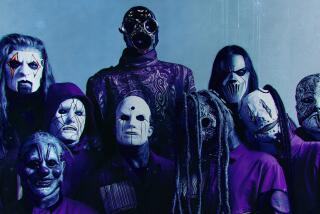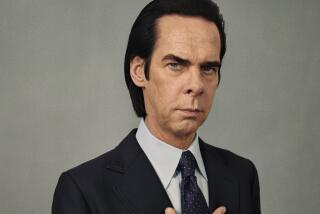Look into this mirror
Korn is accustomed to your disgust. The band counts on it, revels in it, thriving as a group of hard-rock outcasts, proud metal misfits and super-creeps.
The Los Angeles-based band has been a consistent million-selling success since its 1994 debut, with radio hits and MTV celebrity, but affection alone is not enough to sustain it. Kornâs mission as a band of outsiders depends on the nonbelievers, critics who hear nothing but noise and hollow exploitation. âAs serious as cirrhosis -- and about as much fun,â declared Entertainment Weekly in 1999.
Itâs true that the music can be harsh, offensive, even toxic in its relentless obsession with the scars of adolescence and sexual abuse. But it is also a mistake to dismiss Korn as a phony creep show without depth or meaning. The sentiment is real, the voice genuine, and the musicians arenât wearing masks or costumes. It reaches young fans on a level too deep to dismiss, sending crowds into a state of tribal ecstasy, bouncing as one to the thundering beats like a young army bound together by joyous self-loathing and shared negative energy.
Such moments offer escape from authority, from adolescent chaos and uncertainty, freeing fans to sing and shout along to an anthem such as 2002âs abrasive âHere to Stayâ: âThe hurt inside is fading.... All this time Iâve been waiting/ No, I can not grieve anymore!â
The music is about rage. It tells a story of alienation, obsession, dementia -- common themes in hard rock that are a creative dead-end for most. But not in the hands of Korn. Rarely has the cause of suburban decay and teenage agony been mastered with such brutal finesse and utter conviction.
For singer Jonathan Davis, there was no other way. His taste for the mad and macabre is no affectation, less about venting than strange catharsis -- shouting, stomping, whispering, shrieking, sputtering across a contemporary metal blend, post-Metallica, post-Nirvana, post-N.W.A.
It has led to one of the most distinctive sounds in metal, a genre too often overloaded with manufactured angst and predictability.
Going off the path
That sound can be an acquired taste for the uninitiated. And the bandâs newest album, âTake a Look in the Mirror,â begins in that familiar mode, sounding for a moment like a path Korn has taken maybe once too often. But soon, Kornâs sixth album stretches enough to dabble in new arrangements and vocal tricks, giving new urgency to old traumas.
It has never been easy listening, even with a scorching layer of funk added to the headbanging, blending ominous, churning guitars into a raw, unstoppable force of Goth metal and industrial noise, and worldwide sales of 20 million albums. Which puts Korn at home both within the metal multitudes of Ozzfest and completely outside the metal mainstream. (The band plays next Sunday at the KROQ Almost Acoustic Christmas concert at the Universal Amphitheatre.)
The bandâs biggest hits -- the madhouse-metal âGot the Lifeâ and the intensely scatting âFreak on a Leashâ -- are as immediate as early Black Sabbath and twice as impenetrable with words of outrage, hurt and helplessness that can get lost amid a rock radio playlist. The themes rarely change, expressing an inner turmoil different from those of Kurt Cobain or Nine Inch Nails, less coherent but equally jarring.
Davis still calls himself an outsider, a classically trained musician living amid his collection of paintings by Charles Manson, John Wayne Gacy and other extremists and serial killers. They represent a morbid fascination with the darkest corners of human behavior, feeding Davisâ own work far beyond the stuff of movie monsters and the playful horror of death metal T-shirts.
He remains haunted and inspired by the events of his youth, as a teenage coronerâs assistant back in Bakersfield, as the loser taunted in high school (as âFaget,â as he titled one song), and more recently declaring himself a victim of childhood abuse.
The hate that resulted is eternal, and the only possible response is to wallow in it, to tap into its power to provoke. The music of Korn has consequently tackled real horrors that bands such as Slipknot typically transform into caricature, far from the desperate world view first articulated on Kornâs debut: âThink about your life, think about your inner fears!â
Child abuse is a recurring theme, with songs and album cover art depicting children in extreme peril or represented by the remnants of damaged playthings. The symbolism is not subtle and can be heard in excruciating detail on the first album, particularly within the song âDaddy,â a grim epic on the effects of abuse that ends with Davis melting down with rage and tears and shortness of breath. The effect is too disturbing, too real to be described as mere performance.
A highlight of many Korn tours is âShoots and Ladders,â typically led by Davis on haunting bagpipes, standing in a black kilt to sing a medley of nursery rhymes, adding ominous new implications to familiar childhood words: âNick nack patty wack, give a dog a bone/ This old man came rolling home.... Ashes, ashes, we all fall down.â Like much in Kornâs world, the result is both dark and strangely comic, like a Tim Burton film.
Hip-hop influence
The sound of Korn has never been about simple muscle flexing. It is music of pain and confrontation, set against the thundering bass lines of Reginald âFieldyâ Arvizu and the primal beats of drummer David Silveria, and fueled by the dueling seven-string guitars of James âMunkyâ Shaffer and Brian âHeadâ Welch.
And yet Korn has been blamed for the dubious genre of nu-metal (a.k.a. rap-metal), though the quintet has always remained firmly outside that lucrative formula, preferring tribal disco rhythms to simple hip-hop beats.
The band never embraced the sound that sent its pals in Limp Bizkit to controversy and success, but an awareness of hip-hop has been an important generational factor in Kornâs rendering of heavy metal. Original gangsta kingpin Ice Cube is a recurring figure, first with a Korn rendition of the rapperâs âWicked,â followed by his guest appearance on 1998âs âFollow the Leader.â (Davisâ attempts at rapping are best ignored, particularly on that same albumâs âAll in the Family,â a duet of cheap insults with Bizkitâs Fred Durst that only diminishes one of Kornâs strongest albums.)
Early on, the band embraced Limp Bizkit and was key to its success. (The bands just finished a tour of theaters together.) Korn also expanded its influence by launching its annual Family Values tour, mixing metal bands with hard-edge rap acts, finding common ground amid words of seething dissatisfaction. There was also Kornâs Elementree label, which enjoyed some initial success with the band Orgy.
Most lasting will be Kornâs own music, so often harsh and relentless and always dark but never so lost in the gloom that it slows down or abandons its narrow focus. It continues to make for disturbing, celebratory moments. The members of Korn are pure in that way, embracing the role of outcasts with a strange kind of duty and conviction.
More to Read
The biggest entertainment stories
Get our big stories about Hollywood, film, television, music, arts, culture and more right in your inbox as soon as they publish.
You may occasionally receive promotional content from the Los Angeles Times.











